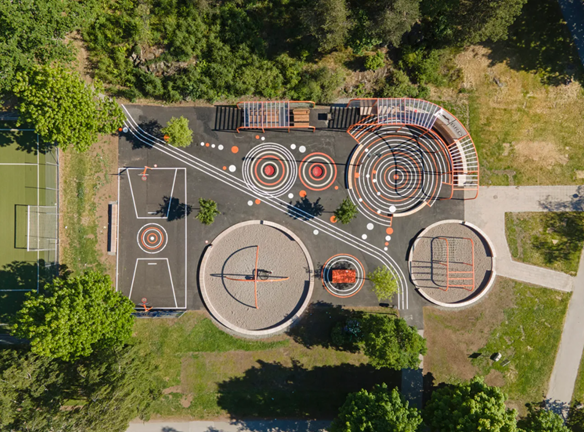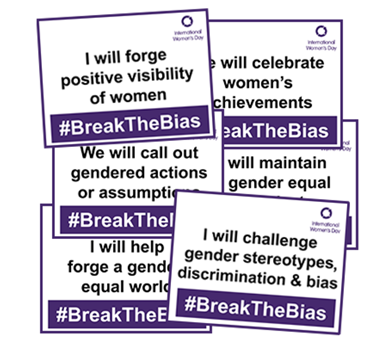International Women's Day (IWD) marks a call to action for accelerating women's equality and, as planners we have a role to play in promoting and delivering equality. This year's IWD theme is 'Break the Bias' and urban planning is certainly a sphere in which this message must be spread. So, how can we break the biases in the way we plan our cities…
1. Urban design strategies
Urban design strategies for developments and public places need to eradicate the gendered nature of many spaces and create an environment that is suitable for women. I have come across the matter of women's ability to safely and fairly access and traverse cities many times, in both my career as an urban planner and in life as a woman. While we may like to think otherwise, it is widely acknowledged that urban areas have historically been designed to be more suitable for able-bodied, heterosexual, cis-gender men.
A sense of space should be created so there are no hidden or isolated crevice-like areas, or routes people, especially women, don’t feel are safe to use at night. Design strategies should be adopted that encourage activation and natural surveillance to ensure women feel safe and happy to pass through and dwell in the public realm. Secure by Design requirements may influence some of these factors but architects must be careful that barriers and crime prevention installations, such as high walls and gates to limit access, do not inadvertently conflict with urban design strategies for women’s safety such as opening up areas and increasing visibility.
Linked to this, there should also be ease of movement around the public realm. For example, consideration is needed of everyday practices still largely undertaken by women, like pushing a baby in a pram. Uneven surfaces and narrow, cluttered pavements do not provide an environment conducive with inclusive accessibility.
2. Necessary street infrastructure
Street lighting, more toilets and step-free access… ordinary but fundamental street infrastructure that needs to be appropriately placed and well-maintained – and should not have to be campaigned for. Quite simply, this infrastructure needs to feature in development proposals; there is a legal and policy requirement for lighting strategies and inclusive access for new schemes, which hopefully highlights these matters early on in the design process and should be in the minds of designers and planners. We can all work to take the minimum requirements further to provide better infrastructure for all. Equal access should not be a tick box exercise.

Change.org: Petition for better street lighting on Clapham Common, following the murder of Sarah Everard – one year ago last week.
3. Consulting underrepresented voices
Consultation is a fundamental part of the planning process and incorporating underrepresented voices in consultation and participation exercises is crucial to designing schemes that work on the ground for the people who will use it. Development teams therefore need to work harder to devise consultation strategies that will allow harder to reach groups and those who may not speak out as loudly as others to give their opinions. The town hall style meeting is clearly not an appropriate forum for everyone…
4. Play space for all
Implementing play space and landscaping strategies that encourage girls and young women to play and interact is a key way to ensure public spaces are less gendered. Make Space for Girls campaigns for facilities and public spaces for teenage girls, in recognition of the fact that the default provision for play space in new developments is to include a skate park, BMX track, football pitch or MUGA, which are used far more by young boys. Check out: https://makespaceforgirls.co.uk/ and especially their Instagram @make_space_for_girls for some interesting case studies and research pieces.
Make Space for Girls: Case study of a park in Stockholm that was designed with a focus group of girls.
5. Women's representation in planning and related professions
I do believe this is improving, but more women at senior levels in sectors related to planning, architecture, development, construction is so key to designing inclusive places. If there is a lack of women in the decision-making chain, women’s experiences are less likely to influence the product. Lichfields’ upcoming Senior Director announcements make me hopeful for more equal representation in the decision-making positions for our company.
6. Funding to tackle inequality
Ultimately, funding is needed for many projects seeking to tackle inequality to go ahead. One GLA initiative, open for applications until late April, is the Civil Society Roots grant, targeting groups led by and for communities impacted by structural inequalities in 10 London boroughs. Grants between £1,000 and £50,000 are available for ideas that help develop new partnerships, for work on a collaborative community project or to invest in capacity building and training: https://www.london.gov.uk/what-we-do/communities/civil-society/civil-society-roots. There are various funds available to help with projects and grassroots ideas which could be utilised for urban initiatives that tackle gender inequality and I am hopeful these are put to good use.
We must deliberately adopt a gender lens when approaching development, to help recognise the differing experiences of women in spaces and ensure that the male experience is no longer the default option in design.
Urban planning and design alone cannot eradicate sexism and violence against women – a societal and structural change is still much needed in that regard – but hopefully the above highlights that there is a lot than can, should and is being done to tackle gender, and other, inequalities in cities.
So, my key takeaway for IWD2022 as a planning professional is to make a purposeful effort to help curate places that are meaningfully designed to accommodate women and encourage others to do the same. Please consider this a plea to those responsible for making places: prioritise inclusive accessibility around cities, adopt a gender lens when thinking about urban planning, and implement thoughtful design interventions on the ground to break the biases currently evident in our urban environments.
International Women’s Day 2022: Download a pledge card here:
https://www.internationalwomensday.com/SelfieCards





